Dev Blog: Ships
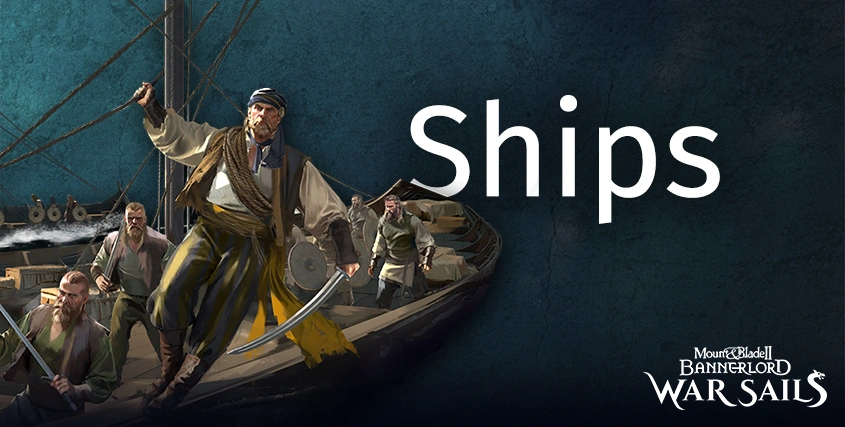
Greetings Warriors of Calradia!
As Calradia’s coastlines open to trade, raiding, and full-scale naval warfare, it’s time to step aboard and take a closer look at the ships you’ll command in War Sails. This developer blog will dive into the variety of vessels, their design inspiration, their performance on the high seas — and how you can customize them to suit your own strategy.
Ship Classes & Sails
Ships in War Sails fall into three core classes — Light, Medium, and Heavy — each tuned for a different role in naval engagements.
Light ships are affordable and tend to excel in acceleration as well as maneuverability — making them the choice for flank attack. However, their lower crew capacity and hit points make them easy targets when caught off guard. Their smaller size also makes them less stable in rough weather and results in fewer potential upgrades.
Medium ships strike a balance between price, durability, deck capacity, and upgrade potential. They are versatile and able to adapt to a range of roles without specializing in any one area.
Heavy ships are built for staying power. Wide decks, large crew capacity, thick hulls, and a wealth of upgrades to pick from allow them to dominate in prolonged engagements — though all of this comes at a hefty price in denars. Their larger size tends to make them less responsive when changing direction, but enables them to power through rough seas in the heat of battle.
Alongside these, some ships carry the Trade designation, a secondary characteristic that applies to vessels built for commerce and logistics rather than combat. Trade ships differ from warships in several key ways: they carry fewer troops, offer more inventory space, and require smaller skeletal crews to operate, making them the preferred choice for merchant convoys.
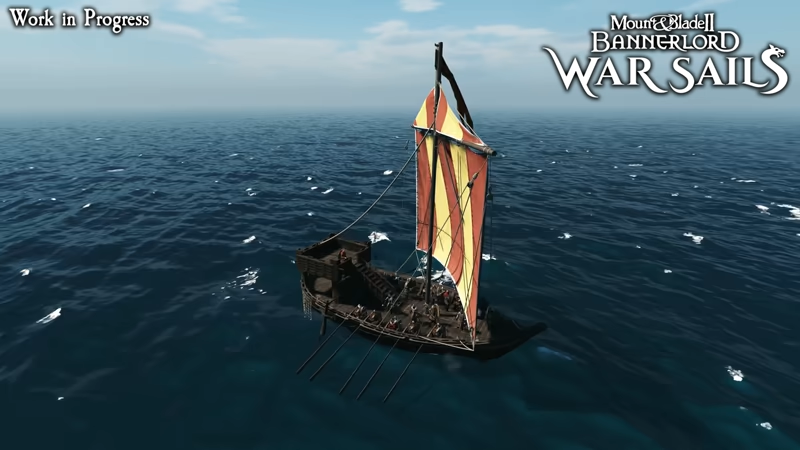
Trade Cog
A ship’s performance at sea is also shaped by its sail geometry, which governs how it handles under varying wind conditions. Square sails offer quick acceleration and perform well in calm winds, but struggle against the wind. Lateen sails catch wind from more directions, enabling higher peak speeds and better versatility, though they result in slower acceleration and lower responsiveness. Hybrid rigs blend both types for steadier control in changing winds. A ship’s sail type is fixed to its design and can’t be swapped, but sail upgrades improve performance within those limits.
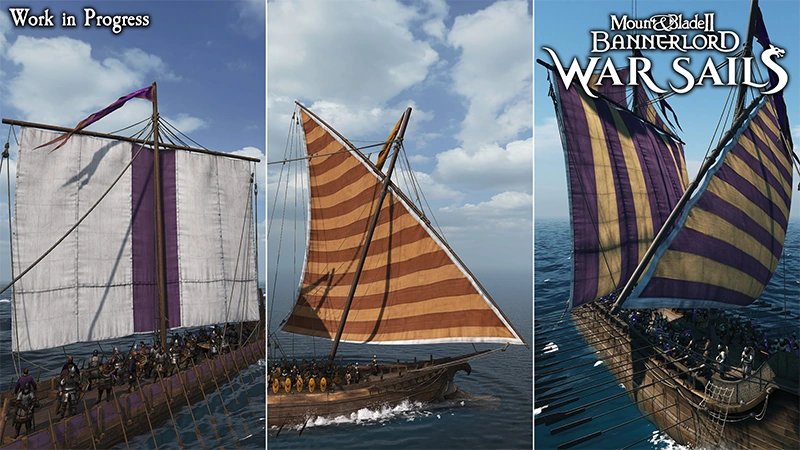
Rig type, left to right: Square, Lateen, Hybrid
Ships
Ships in War Sails are inspired by real-world vessels that match the cultures of Calradia. From square-sailed cogs and roundships in the west to lateen-rigged galleys and sailboats in the east, each ship draws inspiration from historical designs. Every faction fields at least one unique ship reflecting its identity, while drawing the rest of its fleet from shared regional pools — bringing the total to 20 unique ships. However, not all factions have access to every ship class. For instance, the Empire employs vessels across all sizes, while the Nords use light and medium ships geared for boarding.
Access to these ships depends not just on location, but also on infrastructure. Ports must be upgraded via settlement projects. A low-level shipyard might offer only a few light ships, while higher levels unlock medium and heavy ships, with more vessels for sale.
The Empire’s navy is the most well-rounded in Calradia. Their fleet includes the Liburna, a medium vessel with a compact hull and sharp contours, built to withstand hits and even deliver ramming strikes. The Dromon, their heavy flagship, is a broad, high-decked vessel with hybrid sails and tall sides, evoking the form of historical dromons. It’s designed to serve as a command ship, with ample space for crew and inventory, offering endurance and control in large-scale engagements.
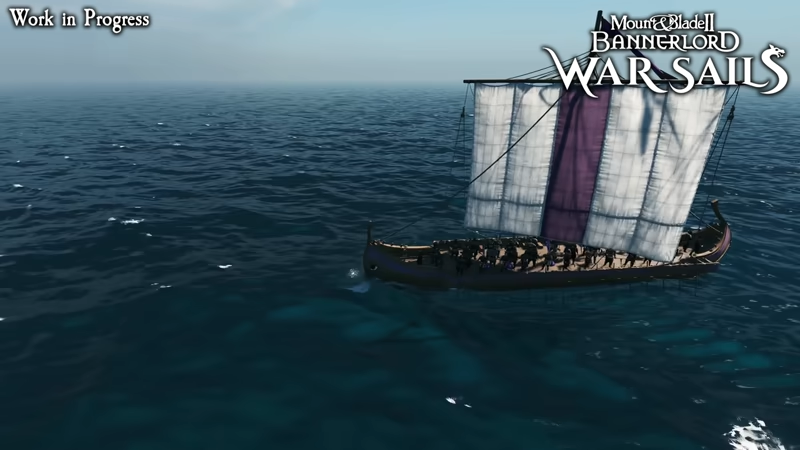
Liburna and Dromon
Aserai ships combine sleek sailboat hulls with galley-like decks. Their heavy vessel, the Ghurab, features a lean frame with high decks and a sharply rising bow, relying primarily on sail power for speed while offering modest oar support for repositioning. Though slower to accelerate, its latten sails allow for higher speed with excellent wind coverage.
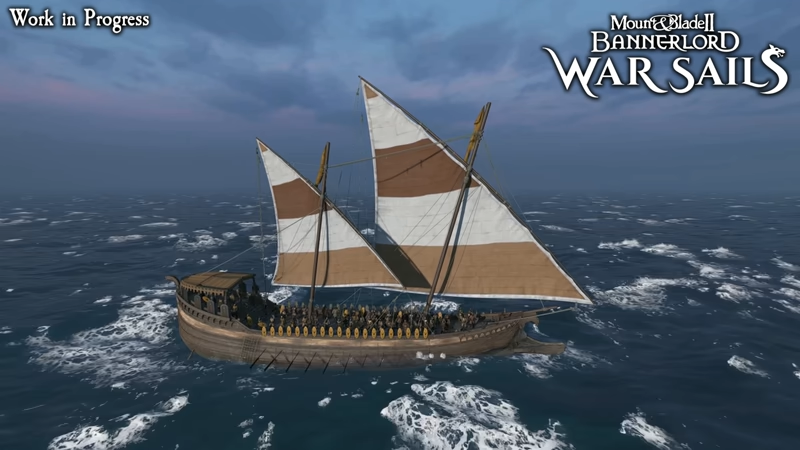
Ghurab
Battania draws from riverine and woodland traditions, producing vessels reflecting this. Inspired by the real-world birlinn, a ship used in medieval Scotland. The Battanian Birlinn is a light, square-sailed ship with a narrow hull and modest height, designed for speed and agility in calmer waters. Its open deck layout supports ranged combat well, though limited crew capacity makes it more vulnerable to boarding and less effective in longer engagements.
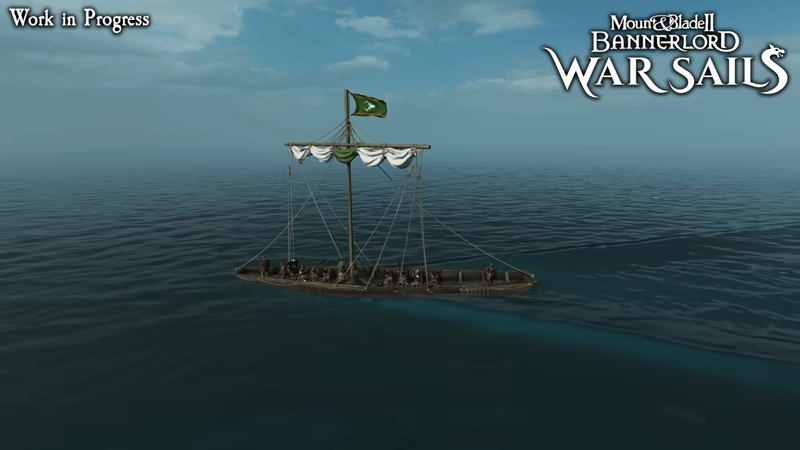
Birlinn
The Khuzait bring their nomadic speed and skirmishing tradition to the sea with ships like the Qalguk. This heavy flagship has a wide, long hull equipped with lateen sails. Its high speed, paired with solid deck space and archer positions, makes it ideal for long-range pressure. However, like most lateen-rigged ships, it suffers from lower acceleration and lacks strong oar support.
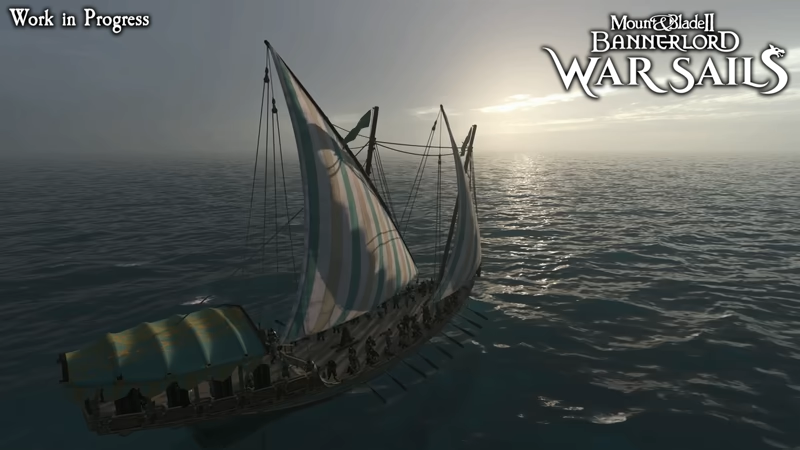
Qalguk
Sturgia’s ships focus on strength, oar power, and cold-water resilience. Their heavy ship, the Lodya, blends the structure of a galley with the profile of a longship — featuring a long hull and open deck that emphasizes deck capacity. It is built for pushing through volleys and closing the distance for decisive boarding actions. It boasts strong oar power while retaining decent sail capability.
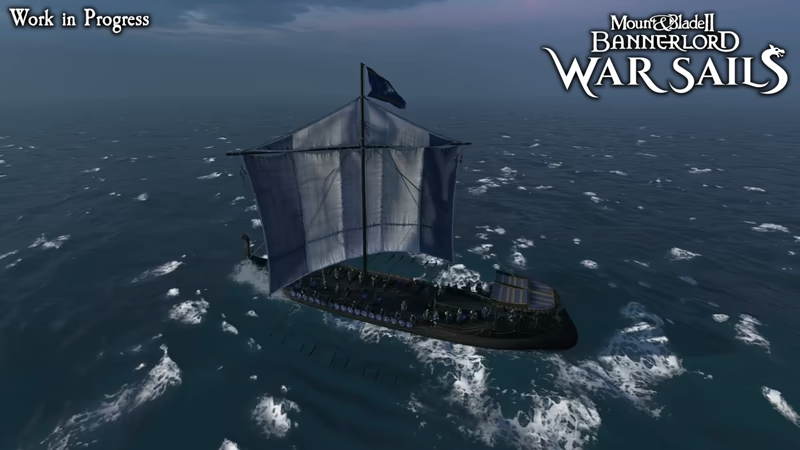
Lodya
Vlandian fleets draw inspiration from the sturdy cargo vessels of northern Europe. Their heavy ship, the Roundship, features a tall, boxy hull with elevated decks — ideal for ranged support. It has modest oar power but makes up for it with strong defensive structures and commanding lines of sight. With its height and layered platforms, it resembles a floating fortress.
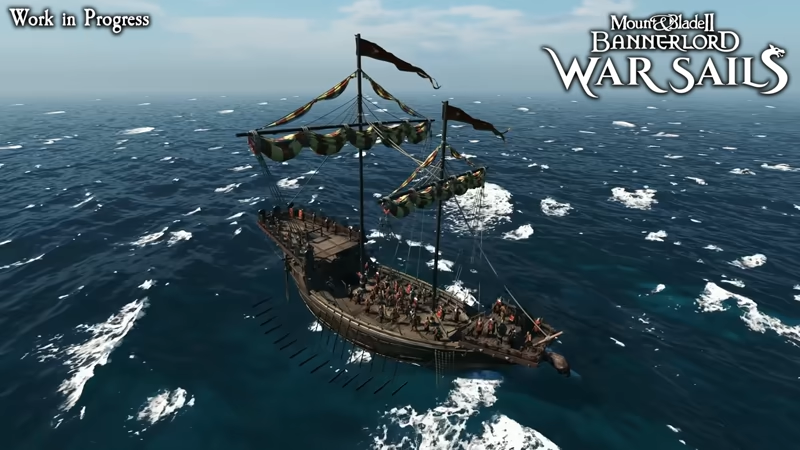
Roundship
The Nords field longships built for decisive, close-quarters combat. Their flagship, the Drakkar, is a medium, open-decked vessel with a narrow, elongated hull and pronounced prow — designed for acceleration. It relies heavily on powerful oars and boarding. While its exposed design offers little protection against missiles, its aggressive profile and fast acceleration allow it to close the gap fast, overwhelm the enemy with numbers, and claim the deck before arrows become a concern.
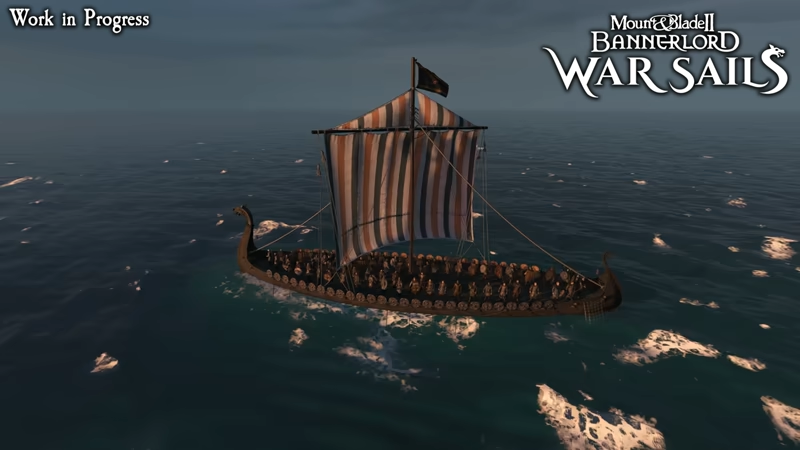
Drakkar
Ship Customization
Pulling into port is where a bare hull becomes your ship. It starts with a name — a single word or phrase that marks the vessel as your own, setting the tone for every voyage to come.
But naming is only the beginning. From there, the real tinkering begins. Ships come with a variety of upgrade slots, such as the aft, hull, sides, sails, and more — though not every vessel supports them all. Dromons, for example, can be fully decked out, while smaller hulls omit those parts that don’t fit. Most upgrades progress through tiers, steadily enhancing performance: some improve troop melee damage, add quivers for archers, expand cargo space, or boost seaworthiness. A select few provide meaningful branching choices — parts that alter how a ship performs in specific situations.
Ships with a fore slot, for example, can mount a ballista for added ranged power. Alternatively, they can be fitted with a battlement — a fortified platform that increases crew capacity, adds weight, and boosts durability, ideal for vessels heading into the thick of close-quarters boarding.
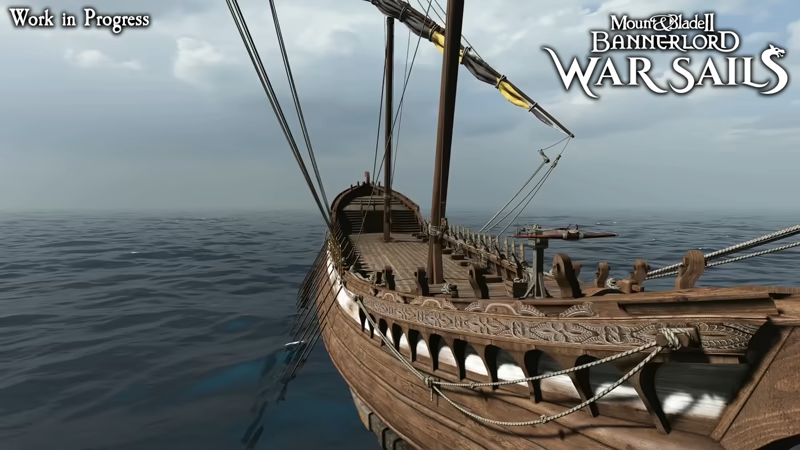
Balista vs Battlements
The sides are another key area of customization. You can install rows of shields to protect your deck crew during ranged exchanges, or equip braziers instead — sacrificing defense for fire arrows that can threaten enemy sails.
And like other upgrades, even decorative elements can carry weight in combat. Figureheads blend visual flair with tactical value, similar to banners on land. A Khuzait ship may sail with a horse prow that improves its travel speed, while an Aserai vessel might be seen with a hawk or viper for better ranged precision or faster ballista reloads. Some figureheads improve the attached ship’s crew battle morale, others enhance ramming or boost throwing weapon damage — giving you the freedom to match form and function across your fleet.
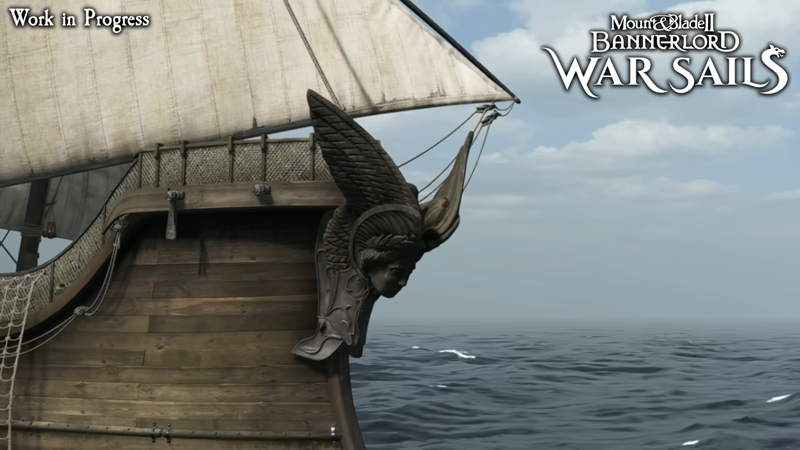
Figureheads
Ship upgrades also require matching port levels, and can differ from culture to culture. For example, you might choose to acquire a Dromon from the Empire region, but you will need to make your way to a Battanian port in order to install boarding weapon upgrades.
And that wraps up another War Sails developer blog! Drop any questions you might have in the comments below, and join us on our socials where we continue to share development updates.

